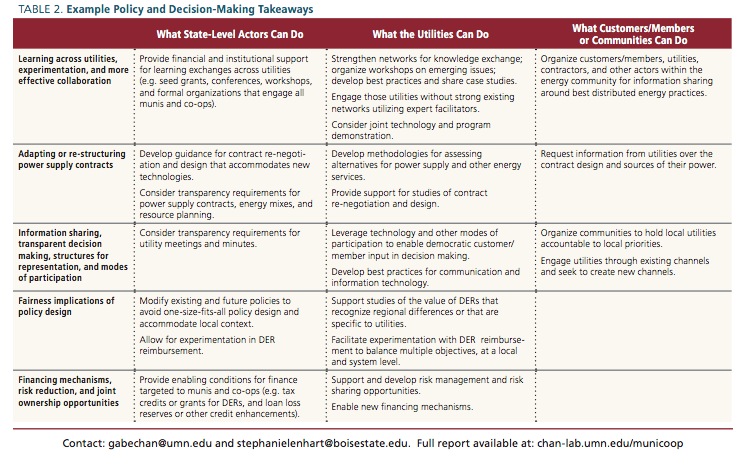
Great report "Barriers and Opportunities for Distributed Energy Resources in Minnesota’s Municipal Utilities and Electric Cooperatives" written by Gabriel Chan, Stephanie Lenhart, Lindsey Forsberg, Matthew Grimley, and Elizabeth Wilson.
Access the report and the executive summary here: https://chan-lab.umn.edu/municoop
Here's an excerpt and table from the executive summary:
"Our team conducted a two-year research project to investigate the landscape of Minnesota’s munis and co-ops. Our focus is on how these utilities are confronting new challenges and opportunities emerging from smaller-scale, often-more sustainable distributed energy resources (DERs), such as rooftop solar, community shared solar, LED light bulbs, controllable water heaters, and electric vehicles.
Munis and co-ops were built to serve their communities through participatory governance and local authority. They make decisions in fundamentally different ways than for-profit utilities. Generally, munis and co-ops are smaller utilities, but as power generation was increasingly deployed by larger centralized fossil fuel power plants decades ago, munis and co-ops had to work together to benefit from economies of scale. This led to a number of decisions that reduced costs for customers/members while ensuring reliability—for example by creating joint action agencies (JAAs) and generation and transmission cooperatives (G&Ts) that collectively invest and procure large amounts of generation (see figures below). However, these same decisions, optimized for lowering cost and improving reliability in a different technological era, have left a legacy of institutional and contractual relationships that are constraining some opportunities today.
In the past decade, as DERs have become more economic, munis and co-ops have approached DERs in different ways than investor owned utilities. Across munis and co-ops, there is a wide diversity of responses to DERs. The large variation across Minnesota’s 125 munis and 45 co-ops is driven by where they are located, whether or not their load and revenues are increasing or decreasing, from which organizations—and under what contractual restrictions—they purchase power, the degree to which they have already invested in DERs, their internal staff capacity and resources, and local demand for cleaner forms of energy, among other factors."

Access the report and the executive summary here: https://chan-lab.umn.edu/municoop
